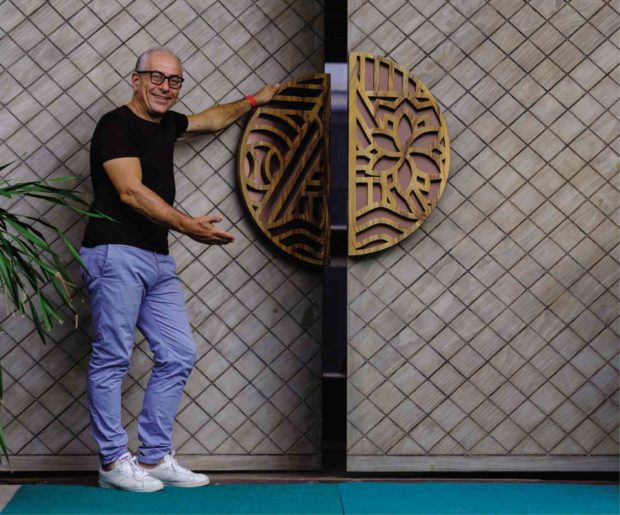The Philippines lacks public spaces where people can converge and connect. To address this problem, Asmara, which calls itself an “urban resort,” was created in Cebu to welcome all kinds of people in a relaxing environment.
The resort is the first development designed by Italian financial controller/analyst-turned-furniture designer Carlo Cordaro. Asmara, the capital of Eritrea in East Africa, is his birthplace.

The 800-sq m urban resort is located in Banilad, beside the affluent Maria Luisa subdivision in Cebu City.
For a modest fee of P500, you can spend a day lazing around the lounge, using the swimming pool or playing ping pong. The tennis and squash courts are rented by the hour.
The second floor open deck is an events space.
Since its opening, Asmara has attracted theater groups for rehearsals, yoga practitioners who savor the deck that opens to a coconut grove, companies for special events, Cebu’s who’s who, as well as tourists.
“Two years ago, I thought Cebu was bustling, but the quality of life was deteriorating with the traffic and pollution,” says Cordaro. “For leisure, you have to go to Mactan resorts which can take 90 minutes because of traffic. You have to allocate three hours to have a mojito on the beach. Cebu is congested. There’s a need for breathing space.”
In most interviews Cordaro recounts how Cebu has hosted him for 23 years, and Asmara is his way of giving back to the place.
In 1996, Cordaro arrived to fix up an ailing company, Cebu Fil-Veneer, one of the country’s pioneers in wooden surface treatments.
Water catchment
After restructuring the company and restoring its profitability, he then bought it from the Italian owner. Despite having no background in design, he used his imagination to create furniture, which caught the eye of the late Araceli
Pinto-Mansor, then executive director of the Center for International Trade and Export Missions (Citem). She invited him to join Movement 8, a group of designers who would promote Philippine furniture and accessories to the world in 1999.
Cebu Fil-Veneer and Cordaro’s Atelier—A design company have since been earning corporate accounts.
Because of his love for Cebu, Cordaro wanted to help put some soul into the city with unique architecture that stood out from the uniform boxes.
Asmara stands out for its pyramid silhouette. Assembled with prefabricated technology, the structure is completed in nine weeks.
“This building is extremely resistant to earthquake and termites,” he says. “It can withstand 240 kph winds during a typhoon.”
The architecture is distinctive for its inclined posts that create visual interest, and a
funnel-shaped water collector right in the middle of the lanai. The roofline is slanted toward the opening of the catchment to facilitate the flow of water when it rains.
“There is a rationale and function in everything that I do,” he points out.
The architecture addresses the water problem in Cebu.
“I want to convince Cebuanos and Filipinos that water collection is important,” he says. “Forty percent of Cebu doesn’t have water at home.”
Cordaro built two cisterns which can store and filter thousands of liters of water coming from the catchment.
Eritrean, Filipino details
The building materials such as pinewood, tempered glass and glulam for the posts also bolster the sustainability of the design.
Glulam, or glue-laminated timber, is the same engineered wood used in the new Mactan International Airport. It consumes less energy than making a beam or post.
The cantilevered balcony also functions as an eave to protect the lanai from the sun and rain.
Since Asmara was built around a coconut grove, the trees provide shade and protection from the elements.
The copper rain gutters are not only extremely durable, but also add a stately appeal.
Some details have references to the Philippines and Asmara, which was once part of Italian Eritrea (or the “Italian Colony” in Eritrea), where Cordaro was raised.
The marquetry on the doors and the flooring suggests the parquet flooring typical in most Italian homes in Asmara.
Filipino elements such as solihiya or woven transoms, abaca-lined cabinets and lampshades, coconut fiber-covered chairs, and abaca rugs blend with the contemporary Italian leather sofas.
The carved handles on Asmara’s door entrance pay homage not only to the Italian colony’s woodworking but to local craftsmanship as well.
The curved backs of the bar chairs evoke a vintage look. “We want to recreate the old way of sitting,” says Cordaro.
He likewise highlighted rare Philippine softwood in table and chair sets.
The lanai is decked with islands of Cordaro’s furniture where people can interact.
The lanai has a modest-sized, glass-covered Italian restaurant.
Overlooking the swimming pool, a ramp leads to the second-floor open deck. People can book their private functions in the glass-enclosed room with a balcony.
Despite suggestions on focusing on a selected clientele, Cordaro refused to go for exclusive membership in order to attract a younger market.
“The young will not need to use their smartphones here,” he says, adding that “this ambience is designed for live dating. I plan to give a discount if people leave their smartphones behind.” —CONTRIBUTED